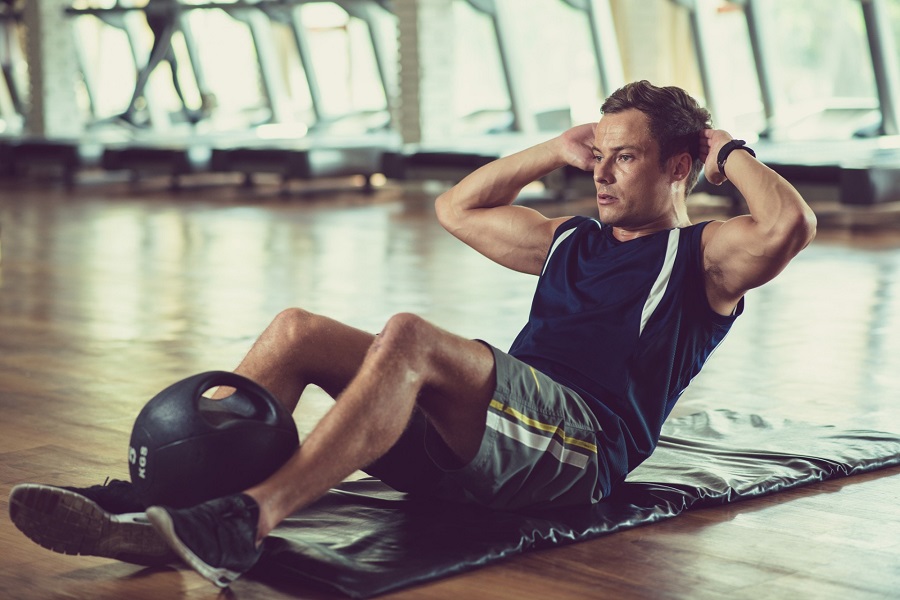The abdominal muscles are composed of the rectus abdominis, the internal oblique muscle, the external oblique muscle, and the transverse abdominis. The traditional sit-up is from lying down and flexing the knees to sitting up, mainly moving to the muscles near the hip joint. The training effect of abdominal muscles is limited. In contrast, crunches are only aimed at training the abdominal muscles, which is a better choice for exercising abdominal muscles. Difference Between Crunches and Crunches
Sit-ups are movements from lying down and bending your knees to sitting up, which can activate the muscles of the neck, chest, hip joints, lower back, calves and abdomen. In the process of doing sit-ups, it is often easy to cause neck strain, spinal or lower back compression and injury due to wrong posture, force position or speed. Therefore, many people will use crunches instead of sit-ups when practicing abdominal muscles. sit. Crunches are smaller than sit-ups and are considered half-sits, mainly exercising only the abdominal muscles. Sit-ups from lying flat to sitting up, the lower back will be completely off the ground. The crunch only slightly rolls up the upper body, and the lower back is still attached to the ground.
How to properly curl up?
Bend your knees at 90 degrees, put your feet flat on the ground, put your hands around your chest or lightly touch your ears, use your abdomen to slightly roll up your upper body (no more than 45 degrees), stop for about 2 seconds and then slowly lie down (do not Lie flat on your back, about your shoulders), and follow the breathing rhythm of “exhale when you get up, inhale when you lie down”. In addition, here are a few other things to keep in mind when exercising:
- Can not be practiced on a bed that is too soft
In fact, whether you are doing sit-ups or crunches, you should avoid doing it on a mattress that is too soft, because the mattress is too soft and it is easy to lose the support of the spine, which not only leads to incorrect posture, but also makes the muscles unbalanced. , it may also damage the lumbar spine, the better way is to lay a soft cushion on the floor.
- Hands should not hold your head
When holding the head with both hands, many people tend to use the wrong way of applying force to lift the head and upper body with both hands, resulting in neck strain and inability to effectively exercise the abdominal muscles. Knees, hands on the chest or lightly on the ear side can avoid similar wrong application of force and the cervical spine injury, and with the different hand positions, the degree of difficulty is slightly different, basically the difficulty is hand on the ear Side hugs on the chest and hands flat on the ground. Put your hands on the sides of your ears or behind your head. Hands clasped in front of chest. Bring your hands together and touch your knees.
- The upper body should be “rolled up” instead of “raised”
When crunching up, you should imagine the spine slowly “rolling up” off the ground, so when viewed from the side, the upper back, shoulders, neck and head will slightly form a curling arc, but if the force is wrong , it will be like a rigid straight line. After crunches up, the upper body should form a slightly curved arc rather than a straight line.
- It is more effective to adjust the speed
Some people have the fitness myth that “the faster you do, the more effective”, but in fact, when doing abdominal exercises, you should try to slow down as much as possible to increase muscle control. You can also try to “get up a little faster, Lie down slowly” at a rhythm.
How to exercise abdominal muscles through crunches?
The above-mentioned basic crunches are mainly to exercise the rectus abdominis (upper part), but if you want to have a well-proportioned and beautiful abdominal muscle line, you cannot ignore the exercise of the internal and external obliques and transverse abdominis.
- Deformed Crunches – Weight-bearing Crunches
After a period of basic supine crunch exercise, you can increase the weight by holding dumbbells, medicine balls and other props to increase the intensity of the training. Muscles exercised: rectus abdominis
- Deformed Crunches – Reverse Crunches
Lie flat on the ground, palms close to the ground, feet together, knees and hip joints at 90 degrees, through the strength of the abdomen, roll the legs and buttocks inward, pause for a while, then slowly lower the feet, the process Keep the angle between the knee and the hip joint as constant as possible. Muscles exercised: Lower rectus abdominis
- Deformed Crunches – Twisted Crunches
The preparatory action is the same as the basic abdominal crunch, lie on the ground, bend the knees at 90 degrees with both feet, the soles of the feet are flat on the ground, the hands are lightly placed on the sides of the ears, and the elbows are extended to the sides, and the upper body is rolled up through the strength of the abdomen Cross your body slightly from side to side, keeping your elbows as wide as possible during the process. Muscles exercised: External obliques, internal obliques
- Deformed Crunches – Bicycle Crunches
Lie on your back with your legs straight, put your hands on the sides of your ears, bend your right knee to your abdomen, use your abdominal strength to bring your left elbow closer to your right knee, and keep your left foot in the air (beginners can lay flat on the ground), pause for a second and then switch sides. Muscles exercised: External obliques, internal obliques


